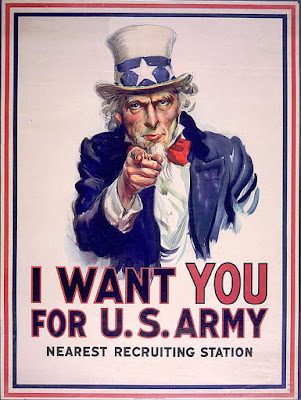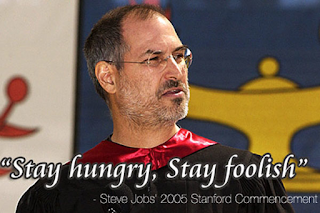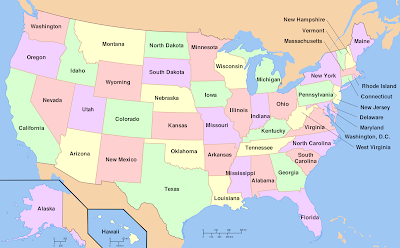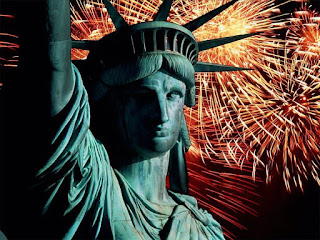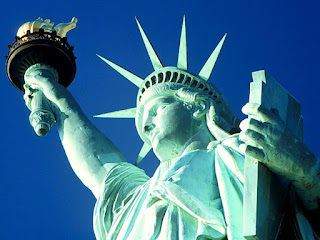Each of the
fifty US states has a nickname. It is one of the most folkloric customs of the
United States of America for many reasons, from patriotism to remember some of
the historical peculiarities that the state has been in the past 240 years. Plants,
animals, ideas. It all goes well for being written on placards or official
flags and to outline in two words the history of each state.
Below are
reported the nicknames of the US states, including (in bold type) those
officially used or traditionally assigned to states or districts in the United
States.
1.
Alabama
Yellowhammer State, Cotton Plantation State, Cotton
State, Heart of Dixie, Lizard State, Camellia State
2. Alaska
The Last Frontier,
Great Land, Land of the Midnight Sun, Land of
the Noonday Moon, Seward’s Folly, Seward’s Ice Box, Icebergia, Polaria,
Walrussia, and Johnson’s Polar Bear Garden
3.
Arizona
The Grand Canyon State
Apache State, Aztec
State, Baby State, Copper State, Italy of America, Sand Hill State, Sunset
State, Sweetheart State, Valentine State
4.
Arkansas
The Natural State
Bear State, Bowie
State, Hot Spring State, Land of Opportunity, Razorback State, Toothpick State,
Wonder State, Diamond State
5. California
The Golden
State
El Dorado State, The Land of Sunshine and
Opportunity, Golden West, Grape State, Land of Milk and Honey, Land of Fruits
and Nuts, Where Stars are Buried, The Cereal Bowl of the Nation, The Eureka
State, The Bear State (or Republic), The Sunshine State (disused)
6. Colorado
Centennial
State
Buffalo Plains State, Colorful Colorado,
Columbine State, Highest State, Lead State, Mother of Rivers, Rocky Mountain
Empire, Rocky Mountain State (disused), Silver State (disused), Switzerland of
America
7. Connecticut
Constitution
State
Nutmeg State, Charter Oak
State, Blue Law State, Freestone State, Land of Steady Habits
8. Delaware
The
First State
Chemical Capital,
Corporate Capital, Diamone State, Blue Hen State or Blue Hen Chicken State, Home of Tax Free
Shopping, New Sweden, Peach State, Small Wonder, Uncle Sam’s Pocket
Handkerchief
District of Columbia
The District
A Capital City, The Federal City
9. Florida
Sunshine
State
Alligator State, Citrus
State, Everglade State, Flower State, God’s Waiting Room, Gulf State, Hurricane
State, Manatee State, Orange State, Peninsula State or Peninsular State,
Tropical State
10. Georgia
Peach State
Cracker State, Empire State of the South, of the South, Yankee-land of the South,
Goober State
11.
Hawaii
Aloha State
Paradise, The Islands
of Aloha, Paradise of the Pacific, Pineapple State, Rainbow State, Youngest State
12. Idaho
Gem State
Gem
of the Mountanis, Little Ida, Spud State, Potatonia,
13.
Illinois
Land of
Lincoln
Prairie State
Corn State, Inland Empire
State, Garden of the West
14.
Indiana
Hoosier State
Crossroads of
America, Hospitality State, Sunshine State
15. Iowa
Hawkeye
State
Land
of the Rolling Prairie, Tall Corn State
16.
Kansas
The Wheat State
Sunflower State
America’s Bread
Basket, Wheat State,
Home of Beautiful Women, Central State, Jayhawker State
17.
Kentucky
Bluegrass State
Corn-cracker State, The Dark
and Bloody Ground State, Hemp State, Tobacco State
18.
Loiusiana
The Sportsman’s Paradise
Pelican State
Bayou State, Child of
the Mississippi, Creole State, Fisherman’s Paradise, Holland of America, Sugar
State
19.
Maine
Vacationland
Pine Tree State
Lumber State
20. Maryland
Old Line State
Chesapeake State, America in Miniature, Cockade State, Crab State,
Free State, Monumental State, Oyster State, Queen State, Terrapin State,
21.
Massachussets
The Spirit of America
The Bay State
Baked Bean State, Codfish
State, The Commonwealth, Old Colony State, Pilgrim State, The People’s Republic
of Massachusetts, Taxachusetts
22.
Michigan
The Greate Lake State
Wolverine
State
Mitten State, Winter
Water Wonderland, The World’s Motor Capital, America’s High Five
23. Minnesota
The North Star State
Butter Country,
Gopher State,
Land of 10,000 Lakes, Land of Lakes, Land of Sky-Blue Water, New England of the
West, State of Hockey, Vikings State, Bread and Butter State
24. Mississippi
Magnolia State
Hospitality State, The South’s Warmest Welcome,
The Birthplace of America’s Music, The Bayou State
25. Missouri
Show-Me State
Bullion State, Cave State, Gateway
State, Bellwether State, Lead State, The Great Rivers State, Ozark State
26.
Montana
The Treasure State
Big Sky Country, The Last Best Place
27.
Nebraska
The Cornhusker State
Beef State, Tree Planter’s State, Blackwater
State
28.
Nevada
Battle Born
Silver State
Battle Born State, Sagebrush State
29.
New Hampshire
Granite State
The Live Free or Die
State, Mother of Rivers,
White Mountain State
30.
New Jersey
Garden State
The Crossroads of the Revolution, The Tomato
State
31.
New Mexico
Land of Enchantment
Cactus State, The Colorful State, Land of
Sunshine or Land of Enchantment, New Andalusia, The Outer Space State, The
Tex-Mex State, The Spanish State
32. New York
The Empire State
Excelsior State
33. North Carolina
The Tar Heel State
Old North State, Turpentine State, Variety
Vacationland, Rip Van Winkle State, Land of the Sky, First in Flight State
34.
North Dakota
The Peace Garden State
Flickertail State, Rough Rider State, Sioux State
35. Ohio
The Buckeye
State
Birthplace of Aviation, Mother of Modern
Presidents, The Heart of it All
36.
Oklahoma
Sooner State
Native America, Land of the Red Man
37.
Oregon
The Beaver State
Union State, Pacific Wonderland, Sunset State, Webfoot
State
38.
Pennsylvania
The Keystone State
Liberty Bell State, Independence State, Quaker State,
Toll Booth State
39.
Rhode Island
The Ocean State
Little Rhody
40.
South Carolina
Palmetto State
Sandlapper State, Iodine Products State (disused)
41.
South Dakota
The Mount Rushmore State (since 1980)
Sunshine State (before
1980), Artesian State, Blizzard State, Coyote State, Land of
Infinite Variety
42.
Tennessee
Volunteer State
Big Bend State, Butternut State, Hog
and Hominy State, The Mother of Southwestern Statesmen
43.
Texas
The Lone Star State
Friendship State, Chili State
44.
Utah
The Beehive State
Mormon State, Friendly State (in disused),
Greatest Snow on Earth
45.
Vermont
The Green Mountain State
46.
Virginia
The Dominion State
Mother of Presidents, Mother of States, The
Commonwealth
47.
Washington
The Evergreen State
Apple State
48.
West Virginia
The Mountain State
Panhandle State
49.
Wisconsin
America’s Dairyland
Badger State
Cheese State
50.
Wyoming
Equality State
Cowboy State, Park State, Like No Place On
Earth, Forever West
 There was
a requirement at the time for contractors to stamp their name and where the rations
came from onto the food they were sending. Wilson's packages were labeled "E.A
– US." When someone asked what that stood for, a co-worker jokingly said, "Elbert
Anderson [the contractor] and Uncle Sam," referring to Wilson, though the "US"
actually stood for United States.
There was
a requirement at the time for contractors to stamp their name and where the rations
came from onto the food they were sending. Wilson's packages were labeled "E.A
– US." When someone asked what that stood for, a co-worker jokingly said, "Elbert
Anderson [the contractor] and Uncle Sam," referring to Wilson, though the "US"
actually stood for United States. 

